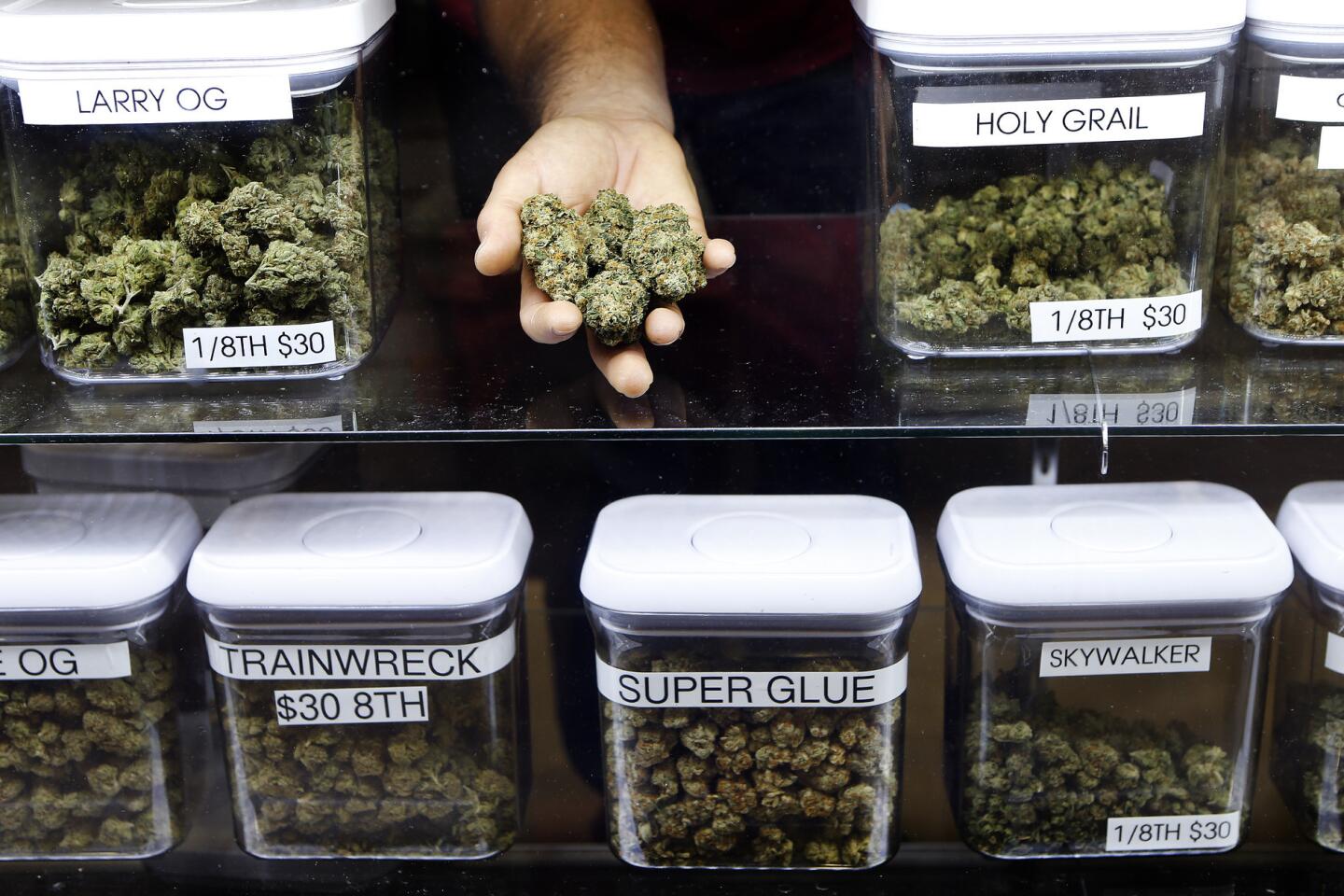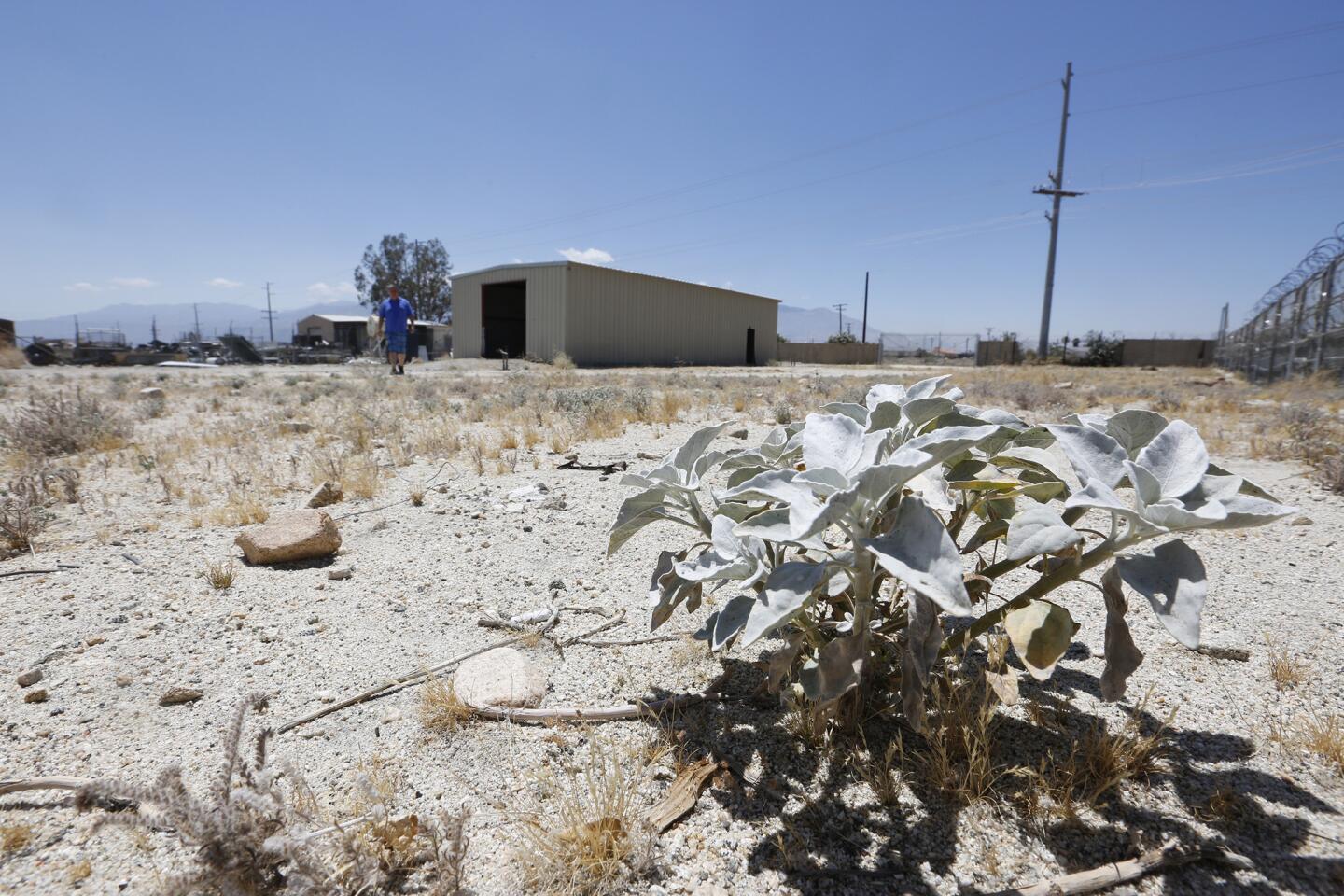This California desert town is experiencing a marijuana boom
Desert Hot Springs, Calif. — Carlos Bravo, the owner of a tow company here, was at work late last year when a real estate agent came to him offering half a million dollars for 5 acres of undeveloped, brush-pocked desert — five times what he’d paid for the land six months earlier.
“I thought he was joking,” Bravo said.
The man came back the next day, making it clear he was not.
A few days after he had signed the paperwork, Bravo said, another man offered him $1 million.
As the first city in Southern California to legalize large-scale medical marijuana cultivation, Desert Hot Springs has been inundated by marijuana growers and developers. They are buying up dusty desert land — some with no utilities or roads — in hopes of cashing in as California’s marijuana growers come into the open under new state regulations.
“It’s pretty chaotic,” said Coachella Valley real estate broker Marc Robinson. “I’m getting tons of calls from all over the world, all over the United States. My newest clients flew over from Germany.”
See the most-read stories this hour >>
Despite a sizable need for new infrastructure to support the indoor growing projects, the rush has officials in this downtrodden town dreaming of new income.
“I can only imagine what we can do with the tax revenue,” Mayor Scott Matas said. “We’re in need of parks, our roads are dilapidated. All around — our sidewalks, curbs, gutters.”
The city is pushing hard to help developers get their projects up and running as it increasingly faces competition from a number of desert cities also eager to bring growers to town.
::
Desert Hot Springs’ foray into marijuana stemmed from financial need, officials said.
The city has long tried to position itself as a Coachella Valley tourist destination alongside its resort-town neighbors south of Interstate 10, but it’s never managed to attract the same level of development. Median household income here is $33,500 — far below the state median.
The town’s destinations simply aren’t enough “for it to become a vibrant and viable city instead of just a dusty little town north of the I-10,” said Heather Coladonato, president of the Desert Hot Springs Chamber of Commerce, which is working closely with growers.
In 2014, after the city declared a fiscal emergency, the council voted to legalize dispensaries and cultivation. Zones where growing was permitted were established, including on a stretch of barren desert dotted with a couple of churches and auto repair shops.
Since the ordinance passed, officials have approved applications for at least 11 businesses with plans for more than 1.7 million square feet of cultivation operations.
Each year, the city will tax growers $25 per square foot of cultivation space for the first 3,000 square feet and $10 per square foot after that. At least eight other projects are in the approval process.
Police Chief Dale Mondary said he had strong reservations about the city’s move toward cultivation.
FULL COVERAGE: Marijuana regulation in California
“Just from a law enforcement standpoint, obviously we’re philosophically opposed,” he said. “I took the stance: ‘I can either pout about it or get on board and at least have my voice heard.’”
The businesses have agreed to hire 24-hour armed security guards and install cameras that police can access remotely, Mondary said. They’re also planting what he called “hostile landscaping” — cactus and other plants that could be difficult for intruders to pass.
No cultivators are up and running yet, though a small number could be growing by this summer, officials said.
Growers, many of whom have been quietly practicing their trade in garages and other underground spaces for years, are eager to “come out of the shadows,” said Jason Elsasser, who is planning a 2-acre project in town.
The rush to set up shop in cities that permit cultivation was pushed forward by state legislation signed into law late last year. Growers will be able to apply for state licenses by 2018, but they will have to show they have local licensing before they can get a state permit, said Steve Lyle, a spokesman for the California Department of Food and Agriculture.
The crush of developers in Desert Hot Springs led to a tripling of land prices in the area, real estate brokers said.
But there are signs that the projects — which require intensive lighting and air conditioning — could face long infrastructure delays. In recent weeks, owners learned it could take years just to get sufficient electricity to some of the businesses.
Southern California Edison spokesman Robert Laffoon-Villegas said the utility expects that some growers’ power needs could be so large that “it would be like adding a small city to the system.”
“In order to do that safely it does require significant study … and it may require significant infrastructure,” he said.
Meda Thompson, a real estate broker who advertises on fliers decorated with marijuana leaves, said the issue has caused some properties to fall out of escrow.
To help address the concerns, the city manager is now preparing to hire a project manager who would oversee infrastructure issues for growers.
In the meantime, the city is facing increasing competition.

Jason Elsasser surveys his property from the doorway of an empty steel shell building in Desert Hot Springs. Elsasser plans to build a 2-acre pot operation in town. “This is going to be all built out into a high-tech, 40-light grow right here,” he says.
In nearby Cathedral City, officials recently began accepting applications from growers and dispensaries. So far, they have received about 20, said Community Development Director Pat Milos.
In San Bernardino County, Adelanto began accepting applications from growers late last year.
That city, which has been on the brink of insolvency in recent years, has asked applicants to sign a statement acknowledging its financial hardship and agreeing to “support, and not oppose, any initiative that the city or the voters of the city initiate to raise business taxes and business license fees.”
So far, it has approved at least 30 applicants who have proposed operating more than 1.2 million square feet of cultivation space. Some, like in Desert Hot Springs, would be in now-vacant desert plots.
The city of Coachella, meanwhile, has opened an area to growers previously zoned for auto wreckage yards.
Mayor Steven Hernandez said he expected the businesses to bring better-paying jobs to the city’s low-income residents, particularly migrant farmworkers.
“I’ve got a lot of people working in the fields every day,” he said. “If I can get those guys into the middle income … they can buy themselves a nice house in Coachella and maybe not have to work so much.”
::
Calabasas attorney Bob Selan is leading an effort by several dispensaries to build a 380,000-square-foot cultivation business park in Desert Hot Springs.
The challenges of building from the ground up in the desert have been great, he said.
“The way you have to design these things for climate control and conserving water and conserving energy, it’s very hard to do it, and it’s very expensive,” he said. “We have consultants, engineers, architects, lawyers, accountants, you name it … on top of that we have all the cannabis experts.”
Though the scramble to establish large-scale facilities has been influenced by the possibility that Californians may legalize recreational use of marijuana this year, Selan said his facility would do fine even without such a law.
“The demand for medical products was so high, this was just to fill the need for that,” he said.
Elsasser, who is planning the 2-acre project, had a successful real estate company in Yucca Valley until the housing crash. The downturn left him with several vacant homes, in which he used to grow marijuana.
“Cannabis cultivation kind of saved me,” he said.
On a recent weekday, he walked through an empty steel-shell building on Little Morongo Road that he plans to soon begin converting into a cultivation facility.
“This is going to be all built out into a high-tech, 40-light grow right here,” Elsasser said, using the number of overhead lights the facility will contain to indicate its size.
Pointing to a chain-link fence surrounded by brush, he added, “Back there is going to be all greenhouses.”
Then Elsasser gestured toward a handful of buildings down the road that were owned by other growers and developers.
“Those are all going to be cultivation,” he said.
Little Morongo Road will eventually be the backbone of a bustling warehouse zone, packed to the brim with growers, Elsasser said.
“This property is right on Park Avenue,” he said, waving toward the desert brush and dusty road and imagining the swanky New York thoroughfare. “It may not look like it. But it is.”
Twitter: @palomaesquivel
ALSO
Some emergency drought rules might be eased, but don’t start hosing down sidewalks
Seeking justice for nephew, Rep. Judy Chu aims to stop military hazing
CHP’s latest headache: Dealing with skateboarders who film their stunts on freeways
More to Read
Sign up for Essential California
The most important California stories and recommendations in your inbox every morning.
You may occasionally receive promotional content from the Los Angeles Times.


















